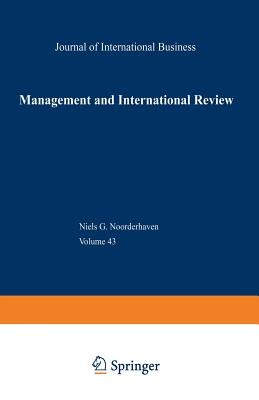
- We will send in 10–14 business days.
- Publisher: Gabler Verlag
- Year: 2003
- Pages: 114
- ISBN-10: 3409124470
- ISBN-13: 9783409124478
- Format: 14 x 21.6 x 0.6 cm, minkšti viršeliai
- Language: English
- SAVE -10% with code: EXTRA
Management and International Review (e-book) (used book) | bookbook.eu
Reviews
Description
units. This can be seen as an indicator of the extent to which the MNC is capable of putting its corporate-level resources to work on aglobaI scale. Becerra and San- tal6 find that about ten percent of the variability of regional units is attributable to corporate effects. The more internationalized the MNC is, the stronger the cor- porate effect. This suggests that the more internationalized MNCs are also more successful in integrating their international operations, whether by employing worldwide home-grown advantages, or by spreading over the entire organization resources and capabilities developed by a particular subsidiary. This integration within the MNC, that can be assumed to be responsible for the stronger corporate effect in the more internationalized MNCs in Becerra and Santal6's sampie, is the focus of Mauri and Sambharya's paper. These authors study the effect of global integration on the performance of the MNC, operatio- nalizing global integration as the inter-area product flows within the multinatio- nal. They find a non-linear relation between global integration and MNC per- formance. At low levels of global integration, there is a negative relation with performance, which turns positive at intermediate levels, but negative again at very high levels of global integration. Their explanation is that at very low and very high levels of integration the balance between the costs and benefits of global integration activities is negative.
EXTRA 10 % discount with code: EXTRA
The promotion ends in 21d.23:06:51
The discount code is valid when purchasing from 10 €. Discounts do not stack.
- Publisher: Gabler Verlag
- Year: 2003
- Pages: 114
- ISBN-10: 3409124470
- ISBN-13: 9783409124478
- Format: 14 x 21.6 x 0.6 cm, minkšti viršeliai
- Language: English English
units. This can be seen as an indicator of the extent to which the MNC is capable of putting its corporate-level resources to work on aglobaI scale. Becerra and San- tal6 find that about ten percent of the variability of regional units is attributable to corporate effects. The more internationalized the MNC is, the stronger the cor- porate effect. This suggests that the more internationalized MNCs are also more successful in integrating their international operations, whether by employing worldwide home-grown advantages, or by spreading over the entire organization resources and capabilities developed by a particular subsidiary. This integration within the MNC, that can be assumed to be responsible for the stronger corporate effect in the more internationalized MNCs in Becerra and Santal6's sampie, is the focus of Mauri and Sambharya's paper. These authors study the effect of global integration on the performance of the MNC, operatio- nalizing global integration as the inter-area product flows within the multinatio- nal. They find a non-linear relation between global integration and MNC per- formance. At low levels of global integration, there is a negative relation with performance, which turns positive at intermediate levels, but negative again at very high levels of global integration. Their explanation is that at very low and very high levels of integration the balance between the costs and benefits of global integration activities is negative.


Reviews